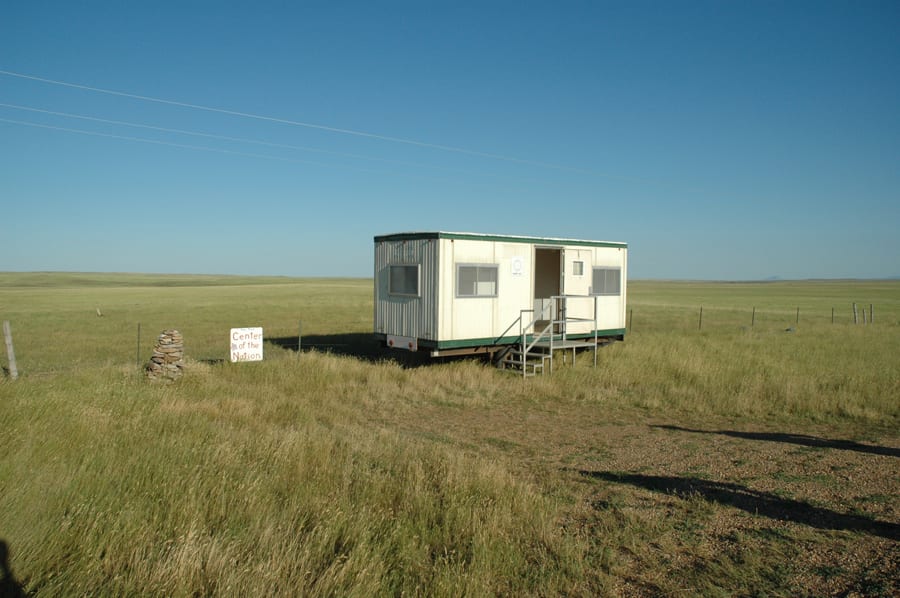From Art Journal 74, no. 3 (Fall 2015)

The starting point must always be that common sense which is the spontaneous philosophy of the
multitude and which has to be made ideologically coherent.
—Antonio Gramsci
Life in Common: A Preface
Common Field was born of a singular moment, a shared time of simmering scarcity matched with an abundance of artist-centric models springing up globally. The emergent network is quickly becoming a central figure within a spectrum of new alternative forms increasingly coming to define a deflated decade. Viewed in relation to postrecession schisms since 2008, the most jarring development in art hasn’t been the stunning capitalization of contemporary art, the crisis in higher education, or increasing institutional biennialization and bloat, but the counter-commons emerging in response to and outside these developments. Within this context, the starting point to gather together as a network was a kind of common sense, in Gramsci’s meaning—a spontaneous philosophy made obvious by a radical expansion of the forms and models artists and arts organizers are adopting, adapting, and speculating about for the field. The task for Common Field was, and still is, how to make this field ideologically coherent.
As best can be distilled, Common Field emerged from conversations at and around the first Hand-in-Glove conference, held in 2011 at Threewalls in Chicago. To those in attendance and involved in the planning, it was clear that this one-off gathering, produced by a single organization, wasn’t enough to take on the questions that emerged: How do we define this emergent field of artist-centric practice? How do we connect, organize, and support others engaging these forms? What can we learn from our inherited legacy, and how are we advancing past it?
From these unanswered questions came an urgency to name the field, to establish forms of support and solidarity, and to gather intentionally to plan next steps. From the outset, it was clear that the undefined terrain didn’t have a shared language, a platform to return to and develop from. The field existed only in informal intersections, personal invitations, and vague social relations: one space collaborating with another, one recommendation leading to the next. The search for models and peers, and particularly shared histories, was disparate and had to be taken up each time individually, producing redundant and reactive models and leading to cycles of frustration for many emerging organizers.
The work in all of its variants—alternative, artist-centered, artist-run—was happening, but no established body existed to gather the work conceptually and physically into one coherent conversation. The founding members of the nascent network took up the task “of renovating and making ‘critical’ an already existing activity” in order to push the work forward through whatever means a national network could offer.1
The loose grouping of artists, arts organizers, and cultural workers who initially gathered to discuss the possibility of a national network of independent spaces was held at Ox-Bow in Saugatauk, Michigan, in late April 2013.2 The group of twenty-four geographically dispersed and conceptually diverse artists, organizers, writers, and mentors was charged with developing a formal organization that would “create a face for the field, develop connectivity among our organizations and colleagues, enable people from across the country to meet face to face, provide practical tools and resources, develop scholarship and research and build awareness.”3 Central figures in its initial emergence include Courtney Fink of Southern Exposure, Shannon Stratton and Abigail Satinsky of Threewalls, Nat May of SPACE, and Elizabeth Chodos of Ox-Bow. However, no single person in attendance already knew everyone who had been invited to that initial planning retreat—it was decentralized and networked from the outset, with a shared methodology hinging it together as a coherent body. In form and founding members, it is hard to not view it as “a network of an antidiscipline” defined as much through its radical otherness than any single shared quality.4
The framing of what this alliance was to consist of was resisted at every step. As any formal quality was proposed, it was quickly countered. Should it be a nonprofit or mirror the informality of many of its members in a more collective model? Does it offer practical resources such as board development, fundraising strategies, and defining best practices? Should it be an advocacy group for shaping funding and policy on a national level or a means of identifying with artist-centric practices? The name itself was changed multiple times before settling into its final form. This active indeterminacy has remained with the project, as it refuses to adopt a more condensed approach, even in the two years since that first gathering, continually electing to reflect the shifting values of the projects it represents rather than preemptively institutionalizing.
However, as open-ended as the planning process was from the outset, the participants converged on a set of shared values: artist-centric practice as a way to combat over-institutionalization, sustainability outside dominant market forces, risk, open-ended inquiry, diversity in all its forms, new means of support (both financial and otherwise), economic equity for artists and arts organizers, non-hierarchical decision making, and mutual support across organizational, cultural, and geographic divides.5 The goals proposed and strategies enacted are radically open-ended and sometimes conflicting, yet overlap as a shared network of individuals pursuing appropriate models for the moment.
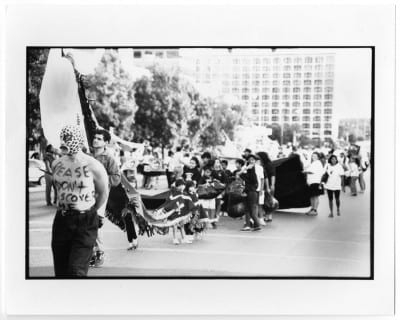
Some of those initial questions have been settled: at present, Common Field is intentionally not a nonprofit.6 Several founding organizations have offered resources to support the project.7 It is organized around a central Cabinet of five to seven individuals and a representative Council of up to twenty members—the artists, scholars, and arts organizers who guide its development. Its membership structure consists of self-nominating groups of visual arts organizers and organizations that pay small membership dues in exchange for the benefits of belonging to the network.8
The structure itself helps bring about the conditions that create a remove from the individual tenor of each project and allow the individuals involved to speak to a form of working that outlasts and transcends each instance. In a notoriously unstable terrain, the network enables a conversation to advance into the future, framing the work for a broader public and making it possible to build on our shared histories.9 In short, the network exists to make the collected individual acts of its members a field.
When we talk of the next phase
When we talk of the next phase of development for artists’ spaces or “alternative” sites, we’ve got to look at what we will be reinforcing, what we will be passing on. . . . When we talk about artists’ spaces, we’re not talking about artists, we are talking about organizations. . . . We need to look at the institutionalization of our organizations, yes, but institutionalization as it pertains not to the “spaces” but to integrating our attitude into life and society.
—Veronica Enrique10
Common Field’s historical roots emerge from the shattered narrative of the alternative space movement and the networks that developed to support it. Most prominently, the National Association of Artists Organizations (NAAO), a largely forgotten legacy in which artist-centered organizations worked together to inform policy, funding, and framing the field on a national scale, has played a significant role in Common Field’s imaginary. Active networks such as ARCA and PAARC in Canada, Cluster in Europe and elsewhere, Triangle, and others have also served as points of reference.11
The impulse to organize emerged predominantly from an urgency of action, with the initial awareness of historical precedents being scattered at best. The search for models, in a sense, came after the rapid expansion of artist-centered spaces and projects over the past decade, as a set of distinct conditions charged the landscape: postrecession scarcity was met with experimental and oppositional modes; artistic practice became more social, ephemeral, and difficult to define; protest movements modulated between art and the broader culture; and the period saw increasing corporatization of institutions, overprofessionalization in education, and inequity among artists. These factors led to a sustained period of experimentation, with the development of new, more equitable support structures. More to the point, the expansive growth of arts organizations has emerged from a radical attempt to define our own space and conditions of existence in relation to the art world. There are references, but no models; histories, but no map. It is a spontaneous philosophy made visible in the practical experimentation of artists and arts organizers.
The particular context in which Common Field emerges marks a new phase to this activity: organizing through networks of commonality and inscribing shared language around the work. Common Field’s call to action is to instill “conscious leadership” in the field, while making this leadership as collective and dispersed as the work from which it emerges. Its conceptual underpinning is an ambitious attempt to understand this work in order to create the conditions required to sustain, support, and expand it.
Organizationally, Common Field mirrors how artist-centric practices themselves work, with collectivity central to the idea. The Common Field network embraces the range of approaches, scales, and geographies, while maintaining a few immutable characteristics: namely, to be for and with artists, to be equitable and fair in finances, to be diverse and inclusive in idea and audience, and to be other to the advancement of the market and marketization of the institution. The commonalities of models (how funding works, how to structure the organization, how to sustain oneself) and the particularities of context (a city’s conditions, individual capacities and interests, and so forth) merge here to form a cluster, a field, a network.
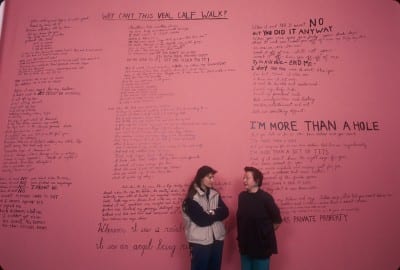
Approaches and scale: From the outset the group consciously considered how to embrace artists and noninstitutional forms in its structure. Common Field’s founding members include non-non-profit artist groups such as Works Progress and DFlux; long-standing nonprofits such as Franklin Furnace, Ox-Bow, and Southern Exposure; and many small to mid-size organizations that have emerged over the past decade, such as Charlotte Street Foundation, Cannonball, The Luminary, Machine Project, and numerous others.
Geography and context: Common Field, echoing NAAO, is a geographically diverse project aiming to cultivate this conversation equally in all contexts. Each project carries residues from its particular place, while the group as a whole advances new models in order to inform and transform art practices nationally and globally. In this way, the network is “trans-local,” rooted in many localities simultaneously while resisting any particular geographic point of view.
This geographic openness is necessary because Common Field modulates between an international conversation and hyperlocal ones, framing and advancing each. The dispersed framework conceives an alternative imaginary that stands distinct from the globalized neoliberalism of the art world. Whether it is Elsewhere, an evolving museum that is inextricable from a single building in Greensboro, North Carolina; Coleman Center for the Arts, a growing contemporary art complex in York, Alabama; or DFlux, a project that started in 2008 when two artists bought a house in Detroit for $100, the majority of the founding members can’t easily be separated from a specific geographic and cultural context.
Networked knowledge and support: A compelling characteristic of the initial membership is that it is punctuated by projects that had previously begun to frame and support the work in interrelated ways through publishing projects, conferences, and funding initiatives. Most prominently, perhaps, Common Field is a direct descendant of the varied work of Threewalls, particularly its directory Phonebook, which documents artist-centered spaces and projects throughout the United States, and the previously mentioned Hand-in-Glove conference, which has continued as Common Field’s primary public gathering. Online publications such as Temporary Art Review and Art of the Rural are other touchstones in conceiving a national conversation about this field through publishing and creating platforms for critical dialogue.12
A distinctive model for many founding members is their enactment of distributed support, most prominently through regranting intiatives. Whether the regrant is informal, through models such as Sunday Soup; individualized, such as the Franklin Furnace Fund; or collaborative, through the Andy Warhol Foundation for the Visual Arts’ Regional Regranting program, for which seven of the nine “regional regranting organizations” are also founding members of Common Field, the idea of channeling resources to unsupported projects (and difficult-to-support structures such as non-non-profits) is foundational.13 As the organizations succeed, their support is often shared, distributed, and dispersed. This is inherently anti-institutional, shedding the accumulationist logic endemic in the art world in favor of a selective sharing of resources found in the network more broadly.
Artist-centricity: Ultimately, beyond any particularities of each project, adherence to shared values and methodologies eclipses other foundational aspects of the network. An originary assumption is implicit in Common Field’s character: artist-centric spaces exist as distinct from most institutions and are a field of their own, intersecting, critiquing, pushing past, and opposing the dominant forms at work in the art world. While the entire founding membership may not agree with an oppositional stance, an underlying critique is at play in which these alternative or artist-centric forms have found the institutional art world lacking, and this lack itself makes the represented projects perennially necessary.
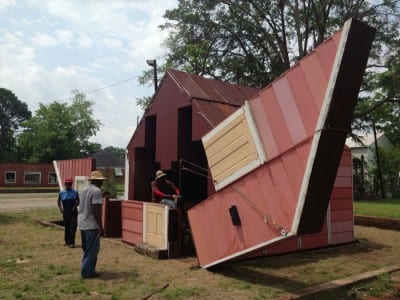
The artist worked with the people of York to transform an abandoned home. When its walls and roof are folded out, it becomes an open-air theater that seats one hundred for performances and film showings.
Fundamentally, the projects within Common Field carry an assumption that artist-centricity implies a wide range of conditions that are alternate to dominant forms. If art institutions could be justifiably defined as artist-centric in their practices, then this distinction wouldn’t carry any meaning. The organizations within Common Field are often founded by artists, but, more important, they engage in the process of working with artists as allies and collaborators, often appearing as much like art projects as institutions in any meaningful sense.14
The models and projects sharing this interspersed space embody a compelling alternative. Linking these within a network posits a further step forward. The multitude of models all point in a similar direction. Can we start to see this multitude come into focus as we assert the sustainability of the alternative in art and other aspects of life? Considering the scale of artist-centric spaces, experimental publishers, alternative schools, and socially engaged actions, the alternative art world poses a compelling narrative of an expansion of these values more broadly. Can we begin to consider the accumulation of these radical acts as a part of a growing chorus of protest and possibility, speaking many languages at once, pursuing many projects at once. Expanding outward from Common Field, I am interested in what work it is performing in a broader landscape: as a commons, as a multitude, as a lasting alternative.
Commoning, or How the Possible Becomes Real
P>We do not have any models to offer for this. . . . Only the multitude through its practical experimentation will offer the models and determine when and how the possible becomes real.
—Michael Hardt and Antonio Negri15
An emergent spontaneous philosophy led Common Field’s founding members to gather, attempting to tie together the proliferation of practical strategies artists and others have experimented with to support their work in an uncertain terrain. The question is, what is this philosophy? What is the possible we are attempting to make real? The idea of the common as both starting place and end point is one answer.
Antonio Gramsci proposes that “the starting point must always be that common sense which is the spontaneous philosophy of the multitude and which has to be made ideologically coherent.” Hardt and Negri extend this further, stating, “Our communication, collaboration, and cooperation are not only based on the common, but they in turn produce the common in an expanding spiral relationship.”16 The motivations that initiated the network are the same shared values it exists to support. The horizon is to make these values common. Put another way, one goal would be to instill artist-centricity within institutions and the art world more broadly: to produce this common in an increasingly expanded terrain.
Lucy Lippard in her recent book Undermining notes this shift as well: “While entangling visual art with the cold realities of our current environment, some artists are realizing that they can envision alternate futures, produce redemptive and restorative vehicles with which to open cracks into other worlds, and rehabilitate the role of the communal imagination.”17 Can Common Field and other latent networks open this crack, habituate the communal imagination in its constituent parts, and create generative alternate futures on a scale enabled by its networked, national structure?
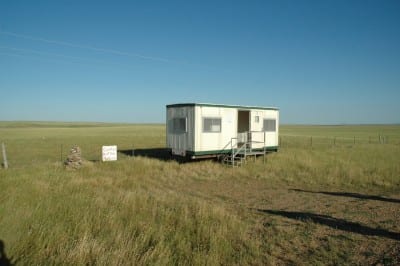
The site is calculated to be the present geographic center of the United States. Other centers marked in the project include a spot in Kansas that is the center of the forty-eight contiguous states, the town of Plato, Missouri, that is the population center of the United States, a lake in North Dakota that is calculated to be the geographic center of North America, and a field in Wisconsin that lies at the intersection of 45° North and 90° West and is thus the center of the northwest quadrant of the globe. http://clui.org/page/center-continguous-united-states
Conversely, the danger is that the network would become another industry group or advocate, “using the idea [of artist-centric practice] without its radicality.”17 There would, of course, be some practical benefits of this—best practices, board development, and the like have a place—but it would produce more sound than effect, so that we risk falling into the traps our historical predecessors encountered. However, we can surpass this possibility and start to consider the agency already in motion through the multitude of projects we are founded on and exist to support. At the current moment, it is as if we are on a precipice where our disparate work meets desperate conditions, where an abundance of models and strategies overshadows the scarcity of resources and support. We critique by building and sustain ourselves by creating a common.
Participation, identification, critical reflection, actively gathering, and, more formally, membership—to actively common these practices is to make a field.
We are commoning a field of practice to give the field a utility that can be taken, shaped, shared, and expanded. If creating a common is our shared project, perhaps the question is, how do we produce it?
I propose three related modes that merge in this work:
Language: Naming the work and describing its emergence itself creates the platform, which in turn creates the common. A shared language, even with contradictory elements, offers an opening, a crack between dissimilar ways of working.
Localized acts: Each organization, localized act, or project in all of its particularities creates the common. It is constantly reproduced in the singular acts of support, sustenance, and experimentation found in localities. The work of establishing an off-grid residency, artist-run gallery, experimental publication, or regranting project creates an expansive common dispersed across geographies.
Circulation: The common circulates and expands as it is shared. The circulation may be through language, ideas, founding narratives, critical texts, or models: physical circulation, as one person travels to another; or economic, as one surplus sustains another. What can the common distribute? What can we distribute to create the common?
This cyclical practice of naming, acting, and circulating together produces the effect of commoning beyond each individual iteration. Its creative remainder is the un-auditable residue of connecting together. Perhaps this is a name one could give to Common Field or any other platform engaging these modes.
What does this common specifically produce? For whom? To what end? On a base level, I think it advances an art world we aren’t ashamed of. It forwards an alternative, equitable art world as possible, as already actualized, as expanding. Naming the activity normalizes it, allows it to be seen as what it is: an astoundingly far-reaching field beginning to claim its terrain.
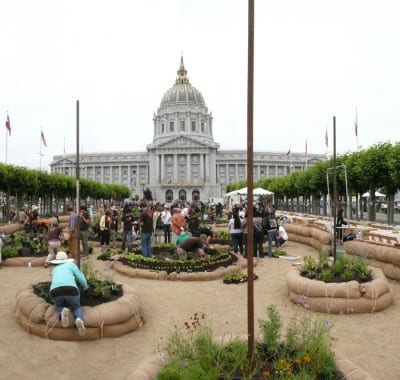
Futurefarmers developed a multipart urban agriculture project with the City of San Francisco from 2007 to 2009. Its utopian proposal in a museum exhibition became a city-supported network of urban farmers who grew and supported home gardens; educated through free workshops, exhibitions, and websites; and planted demonstration gardens on highly visible public lands. www.futurefarmers.com/
Rewilding: We Need Another Worldview
Alternative practices are the mode of our time. We understand them implicitly as we no longer even lament the failure of our institutions, instead electing to remake them or build new ones. The emergence of networks around these alternatives marks a second wave, a mature phase, in which we now work for their lasting impact beyond the individual instances. This is how movements form: when the model is necessary it becomes obvious, then inevitable.
To return to the beginning, we must ask what the project of Common Field is, what the language it proposes consists of and how it brings coherence in a wild field. Common Field, in a sense, comes after the fact. It is necessary now after the alternative has returned, after our institutions have been seen to be sieves through which the market stutters and seethes, after the possible has become real and protest has returned to the West. Our practical experiments
have taken hold. We do, in fact, have models to offer.
McKenzie Wark’s propositions in a recent essay for DIS seem prescient here. He proposes that we need to see ourselves in all of our various roles as having a “common project” and that this “common project [is] building a different world. . . . Can this infrastructure we keep building out . . . actually be the platform for building another one?” He goes on to say that “we need another worldview, one drawn out of what is left of the actually collaborative and collective and common practices via which the world is actually built and run, a worldview of solidarity and the gift.”18
We could ask this outside quotations, more punctuated. Our common project is building a different world. Can this infrastructure we keep building out actually be the platform for building another one?
The alternative or artist-centered project should be defined in generative terms and is not reducible to a narrative in which it arises from a mode of scarcity. Scarcity seems like a partial precondition, as these modes of working often sync with moments of recession and lack of opportunity. However, this alternative does not simply counter institutionalization, it also provides a separate narrative altogether based on solidarity and collectivity. We must acknowledge the infrastructure that has already been built, both through past networks and by our own narratives, as the power our work contains. In this, the alternative should also be viewed in terms of its abundance—the remainder that it produces and that sustains it. As can be seen from the range of spaces and projects presently at work, the alternative movement paradoxically produces a surplus of models. It is clear that the range of activities we see at work is a byproduct of the irreducible intensity of experimentation that follows as we abandon received ideas that no longer work in this shifted terrain. These diverse forms arise when opportunity is decoupled from institutions and inherited modes of working. Once the gates around the institution come down, we leave rather than rush in.
This common created, the accumulation of artist projects and artistic actions, has never been more expansive. Multihyphenated artist-critics, educator-entrepreneurs, and curator-activists meet apartment galleries, pedagogical platforms, and public protests. This is the alternative art world, increasingly seen simply as the art world. How do we acknowledge this abundance, spur it ahead, link it into some understandable multitude? A platform, a network, a common that gathers it, names it, and disperses it.
Common Field is one potential form that is still finding its footing. It arrives at a point of saturation and inevitability in which the growing mode of activity requires new organizational structures as open and undetermined as the projects it supports. The foundational questions of how or if the network will work, who it is for, and where its borders sit are still open. Is the common it creates sustainable, expansive, effective? Can it be an ongoing affirmation of the surplus of alternatives that already exist and those that do not yet, but are emerging? Will it be a means for the common to take root as a rewilding of the field?
The epigraph is from Antonio Gramsci, “Critical Notes on an Attempt at Popular Sociology,” in Selections from the Prison Notebooks, ed. and trans. Quentin Hoare and Geoffrey Nowell Smith (1971; London: ElecBook, 1999), 421.
James McAnally is an artist, curator, and critic whose work seeks to create a space of expanded authorship and exchange. He is the cofounder and executive editor of Temporary Art Review, an international platform for contemporary art criticism that focuses on artist-run and alternative spaces. McAnally is also a founder, codirector, and curator of The Luminary, an incubator for new ideas in the arts based in St. Louis, Missouri. In his artistic practice, he works as a part of the collaborative US English.
- Gramsci, “Some Preliminary Points of Reference,” in Selections from the Prison Notebooks, 331. ↩
- The impossibility of naming one’s own practice was prominent from the beginning, as the group advocated for varying terms, from “arts organizers” to “cultural workers,” and that has never been fully resolved. ↩
- As described in the initial e-mailed invitation to the author on January 16, 2013. Common Field founding members include Kenny Bailey (Design Studio for Social Intervention, Boston, MA), Shana Berger (Coleman Center for the Arts, York, AL), Elizabeth Cline (Machine Project, Los Angeles, CA), Chris Cook (Cannonball, Miami, FL), Kate Hackman (Charlotte Street Foundation, Kansas City, MO), Ben Heywood (Soap Factory, Minneapolis, MN), Kristin Kennedy (Portland Institute for Contemporary Art, OR), Jori Ketten (186 Carpenter, Providence, RI), Colin Kloecker and Shanai Matteson (Works Progress, Minneapolis, MN), Chris Lynn (Spaces, Cleveland, OH), Sharon Maidenberg (Headlands Center for the Arts, San Francisco, CA), James McAnally (The Luminary, St Louis, MO), Jonathan Middleton (Or Gallery, Vancouver, Canada), Maia Murphy (Recess, New York, NY), Victoria Reis (Transformer, Washington, DC), Lane Relyea (Northwestern University, Chicago, IL), Bob Snead (Press Street, New Orleans, LA), Shannon Stratton (Threewalls, Chicago, IL), Andrew Suggs (Vox Populi, Philadelphia, PA), Jon Brumit and Sarah Wagner (dflux, Detroit, MI), Martha Wilson (Franklin Furnace, New York, NY), and Nancy Zastudil (Central Features, Albuquerque, NM). ↩
- Michel de Certeau, introduction to The Practice of Everyday Life, trans. Steven Rendall (Berkeley: University of California Press, 1988), xv. ↩
- This incomplete list is adapted from the brainstorming session at the initial 2013 gathering, as documented by members in attendance. ↩
- Common Field’s architecture actively articulates this indeterminate model: “Common Field performs its operations and programs by leveraging the infrastructures and community networks used by operative arts organizations and independent arts organizers to build an initiative meeting the needs of the field. By utilizing stable non-profit systems and structures, and drawing upon the human resources of more emergent and non-institutional organizers, Common Field can be mutable, responsive, and adaptable to the needs of a community that rapidly evolves.” ↩
- Southern Exposure, Threewalls, and the Soap Factory have each in some way acted as a fiscal agent for various aspects of the project, whether to manage membership fees and convenings, or to apply for grants. ↩
- As noted above, these structures are part of Common Field’s formally adopted architecture as of July 2015. ↩
- As of July 2015, almost a third of the founding members are no longer with their original organizations. This instability of specific context, however, has not deterred the development of the network and instead speaks to its possibilities as a lasting body beyond its individual iterations. ↩
- Veronica Enrique, “To Create a Heart,” in Organizing Artists: A Document and Directory of the National Association of Artists Organizations, ed. Lane Relyea and Penelope Boyer, 3rd ed. (Washington, DC: National Association of Artists Organizations, 1992). ↩
- The initial gathering included members who had been active in NAAO, such as Martha Wilson of Franklin Furnace, Lane Relyea of Northwestern University, and Victoria Reis of Transformer; along with Jonathan Middleton of Or Gallery in Vancouver, a member of PAARC; they lend further perspective on past and current network structures. ↩
- See http://temporaryartreview.com/ and http://artoftherural.org/, as of September 10, 2015. In the interest of disclosure, I am also a cofounder and executive editor of Temporary Art Review. ↩
- Of the nine active regional regranters for the Warhol Foundation, seven are founding members of Common Field: Cannonball, Charlotte Street Foundation, Portland Institute for Contemporary Art, Press Street, Southern Exposure, SPACE Gallery, and Threewalls. Each has other regional partners for the program. ↩
- Some projects, such as Works Progress and DFlux, are explicitly artist projects rather than organizations, but many members productively experiment with those distinctions. ↩
- Michael Hardt and Antonio Negri, Empire (Cambridge, MA: Harvard University Press, 2000), 411. ↩
- Michael Hardt and Antonio Negri, preface to Multitude: War and Democracy in the Age of Empire, (New York: Penguin Press, 2004), xv. ↩
- Jacqueline Cooke, “Art Ephemera,” aka “Ephemeral Traces of ‘Alternative Space’: The Documentation of Art Events in London 1995–2005, in an Art Library” (PhD diss., Goldsmiths, University of London, 2007). ↩
- McKenzie Wark, “Digital Culture and the Anthropocene,” at http://dismagazine.com/disillusioned/discussion-disillusioned/70983/mckenzie-wark-digital-labor-and-the-anthropocene/, as of July 6, 2015. ↩

